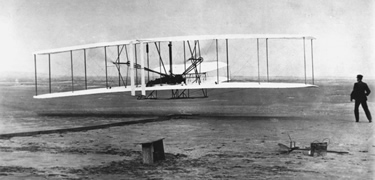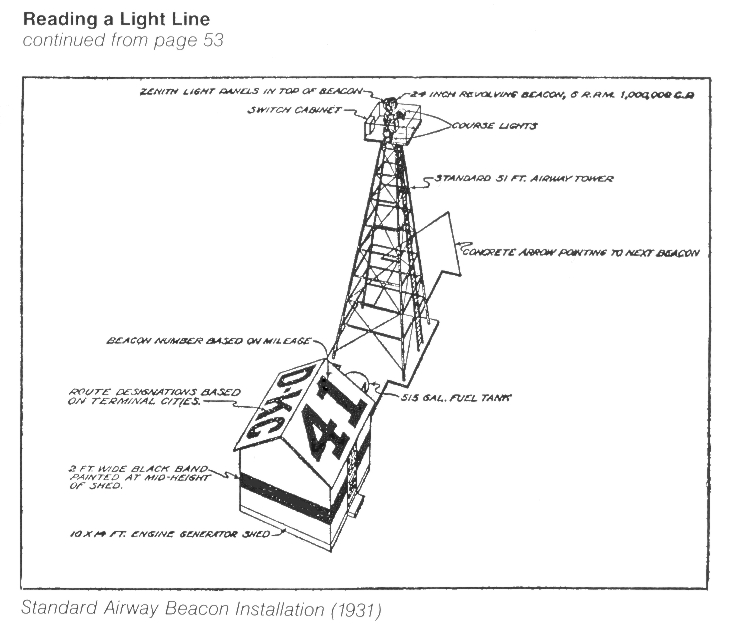

 The Accurate Reloading Forums
The Accurate Reloading Forums  THE ACCURATE RELOADING.COM FORUMS
THE ACCURATE RELOADING.COM FORUMS  Other Topics
Other Topics  Aviation
Aviation  Giant Yellow Concrete Arrows Pointing the Way
Giant Yellow Concrete Arrows Pointing the WayGo  | New  | Find  | Notify  | Tools  | Reply  |  |
| one of us |
Wish I could include picture of one of the arrows and the route graphic. Makes ADF look modern On August 20, 1920, the United States opened its first coast-to-coast airmail delivery route, just 60 years after the Pony Express closed up shop. There were no good aviation charts in those days, so pilots had to eyeball their way across the country using landmarks. This meant that flying in bad weather was difficult, and night flying was just about impossible. The Postal Service solved the problem with the world’s first ground-based civilian navigation system: a series of lit beacons that would extend from New York to San Francisco. Every ten miles, pilots would pass a bright yellow concrete arrow. Each arrow would be surmounted by a 51-foot steel tower and lit by a million-candlepower rotating beacon. (A generator shed at the tail of each arrow powered the beacon). Now mail could get from the Atlantic to the Pacific not in a matter of weeks, but in just 30 hours or so. Even the dumbest of air mail pilots, it seems, could follow a series of bright yellow arrows straight out of a Tex Avery cartoon. By 1924, just a year after Congress funded it, the line of giant concrete markers stretched from Rock Springs, Wyoming to Cleveland, Ohio. The next summer, it reached all the way to New York, and by 1929 it spanned the continent uninterrupted, the envy of postal systems worldwide. Radio and radar are, of course, infinitely less cool than a concrete Yellow Brick Road from sea to shining sea, but I think we all know how this story ends. New advances in communication and navigation technology made the big arrows obsolete, and the Commerce Department decommissioned the beacons in the 1940s. The steel towers were torn down and went to the war effort. But the hundreds of arrows remain. Their yellow paint is gone, their concrete cracks a little more with every winter frost, and no one crosses their path much, except for coyotes and tumbleweeds. But they’re still out there. Don't limit your challenges . . . Challenge your limits | ||
|
| Moderator |
Interesting, I did not know this. Here are some pics:   From here: http://www.cntraveler.com/dail...maphead-ken-jennings for every hour in front of the computer you should have 3 hours outside | |||
|
| Moderator |
And a drawing of how the facility looked:  I found it on this page, which is a rather fascinating website on the history of ATC here in the USA: http://www.atchistory.org/History/nightnav.htm for every hour in front of the computer you should have 3 hours outside | |||
|
| one of us |
At what altitude would the postal service planes be flying? Peter. Be without fear in the face of your enemies. Be brave and upright, that God may love thee. Speak the truth always, even if it leads to your death. Safeguard the helpless and do no wrong; | |||
|
| Moderator |
Here you go, rule #11: PILOT STORIES: Rules for Government Pilots - 1918 All pilots will see to it that these rules are strictly enforced. All infractions will be followed by immediate censure. 1) Pilots will not perform any stunts with mail aeroplanes or put them through any unnecessary strains. 2) Before starting a flight inspect your ship thoroughly and report any defect or negligence on the part of the crew to the chief mechanic and see to it that this defect is remedied before beginning the flight. 3) Before starting on a flight the motors will be run for ten minutes at about 800 R.P.M. to warm them up. This gives an even and equal expansion, lengthening the life of the motor. 4) Pilots will observe a 50 foot dead-line from all buildings and will not take off directly in front of the hangars. Taxi out into the field at least 50 or 75 yards before taking off. 5) Never taxi away from dead-line without the assistance of a mechanic at the wing tip. Be sure that your fire extinguishers are easily accessible. 6) Carry an emergency tool kit, spark plugs, etc. 7) In case of forced landing, first, to save time and to rush assistance when the plane comes down, you are instructed to put in two calls, one for each field you are between, and when one has answered cancel your other call. The relief ship should carry mechanic and the necessary repair parts. The mail should proceed to its destination in the relief plane with the regular mail pilot. THE MAIL MUST PROCEED BY AEROPLANE TO ITS DESTINATION AT ALL HAZARDS AND WITH THE LEAST DELAY. Upon the field receiving such a call, they will notify by wire or telephone the Division Superintendent and will rush a relief plane to the scene of the forced landing at once. Not a minute must be wasted in going to the relief of the plane that is down or in starting the mail from the disabled plane on to its destination. If the relief plane finds that field in which the plane has had the forced landing is not suitable for landing, the pilot should land in the nearest available field and with the aid of the nearest help, team or automobile, transfer the mail and pilot to the relief ship so that the mail can go on to its destination. Upon making forced landings in freezing weather, the pilot is first instructed to drain all water from his radiators, also to turn over the motor to insure complete drainage so as to prevent any part of the motor from freezing. 8) If it is necessary to make a forced landing, get necessary assistance SO AS NOT TO DELAY MAIL IN ANY RESPECT. 9) In case of forced landing in a strange field, make sure that there are no obstacles in the path of your getaway. 10) Carry maps unless you are absolutely sure of the country to be covered. 11) If possible fly over 5000 feet, preferably 8000 feet. 12) Never fly over cities unless you have a safe altitude. 13)Pilots landing with mail should have the right of way over all others. 14)No pilots should carry passengers in Aerial Mail ships unless by written authority of the Second Assistant Postmaster General, or the Superintendent of the Aerial Mail Division. 15) Under no circumstances will the weight of the mail be reduced in order to take a passenger unless authority is given by the Superintendent. 16) Test flights will not last longer than 45 minutes. 17) Hangars must be cleared by at least 50 feet. 18) Compasses must be consulted at all times while in flight. There is absolutely no excuse for pilots deviating from their course if this instruction is followed to the letter. Check up your flights as to compass courses, wind strengths and directions, and keep a relative time table over prominent landmarks. These observations will get you to your destination with least delay to the mail during periods of poor visibility. 19) Always note in pilot's report whenever a ship is delayed more than 10 minutes in getting away, stating whether it be due to the failure of the mail arriving at the field on time or otherwise. 20) When proper authority has been granted for passengers to be carried, the representative at the starting point should place his O.K. on the letter authorizing flight, and when the destination is reached by the aviator and passenger, the passenger will then affix his signature on the letter of authorization and the representative will then forward it to the Division of Aerial Mail Service for the files. 21) Mail will be locked in compartment by the manager of the field and each pilot must carry a key on a chain fastened to his belt or clothing. Each manager and aviator must receipt for the key issued to him and be responsible for its safe keeping, and must keep it on his person at all times. Pilots and managers should take every precaution for the safety of the mail in their custody as some of the mail going by aeroplane is very valuable. 22) Pilots drinking intoxicating liquors within twenty-four hours previous to flying will be punished by their dismissal from the service. 23)Winter clothing. The winter clothing will be in the custody of the field managers who will issue it to the pilot for use while flying, and upon completing his flight the suit must be returned to the field manager and not worn or carried off the field. No exceptions to this rule will be permitted. 24)Inspections must be made beforehand, with a sufficient margin before flying time to allow for minor repairs or a shift to a better ship. 25) Detailed instructions to be issued on this subject from time to time. 26) Ships should never be placed so that a strong propeller blast is thrown into hangars or against ships. Seeing as how gov't rules are usually made as a punitive action, I'd love to learn the circumstances regarding the creation of rules #16 and 17! From here: http://www.postalmuseum.si.edu...lot_tales_rules.html for every hour in front of the computer you should have 3 hours outside | |||
|
| Powered by Social Strata |
| Please Wait. Your request is being processed... |
|
 The Accurate Reloading Forums
The Accurate Reloading Forums  THE ACCURATE RELOADING.COM FORUMS
THE ACCURATE RELOADING.COM FORUMS  Other Topics
Other Topics  Aviation
Aviation  Giant Yellow Concrete Arrows Pointing the Way
Giant Yellow Concrete Arrows Pointing the Way

Visit our on-line store for AR Memorabilia

